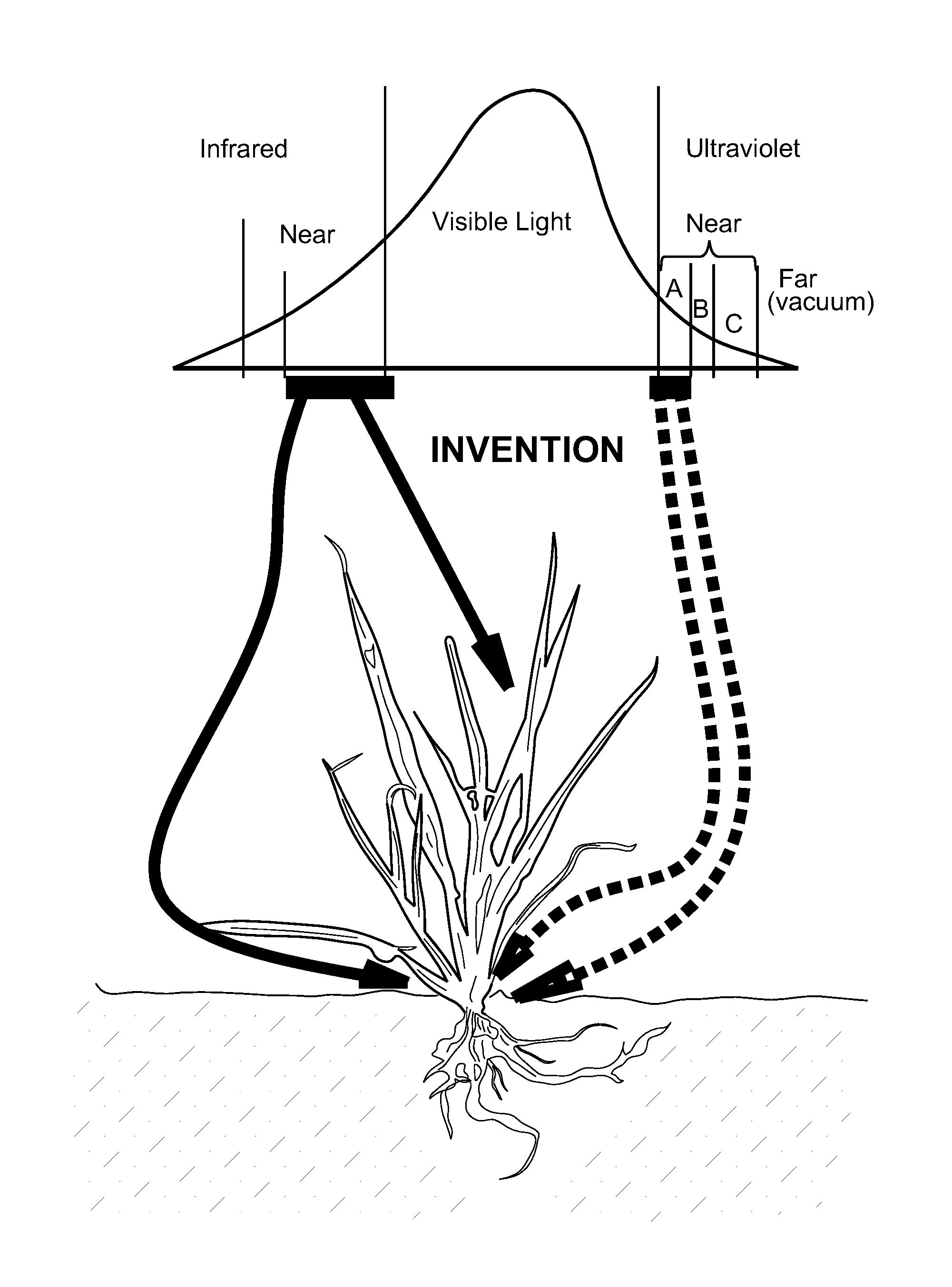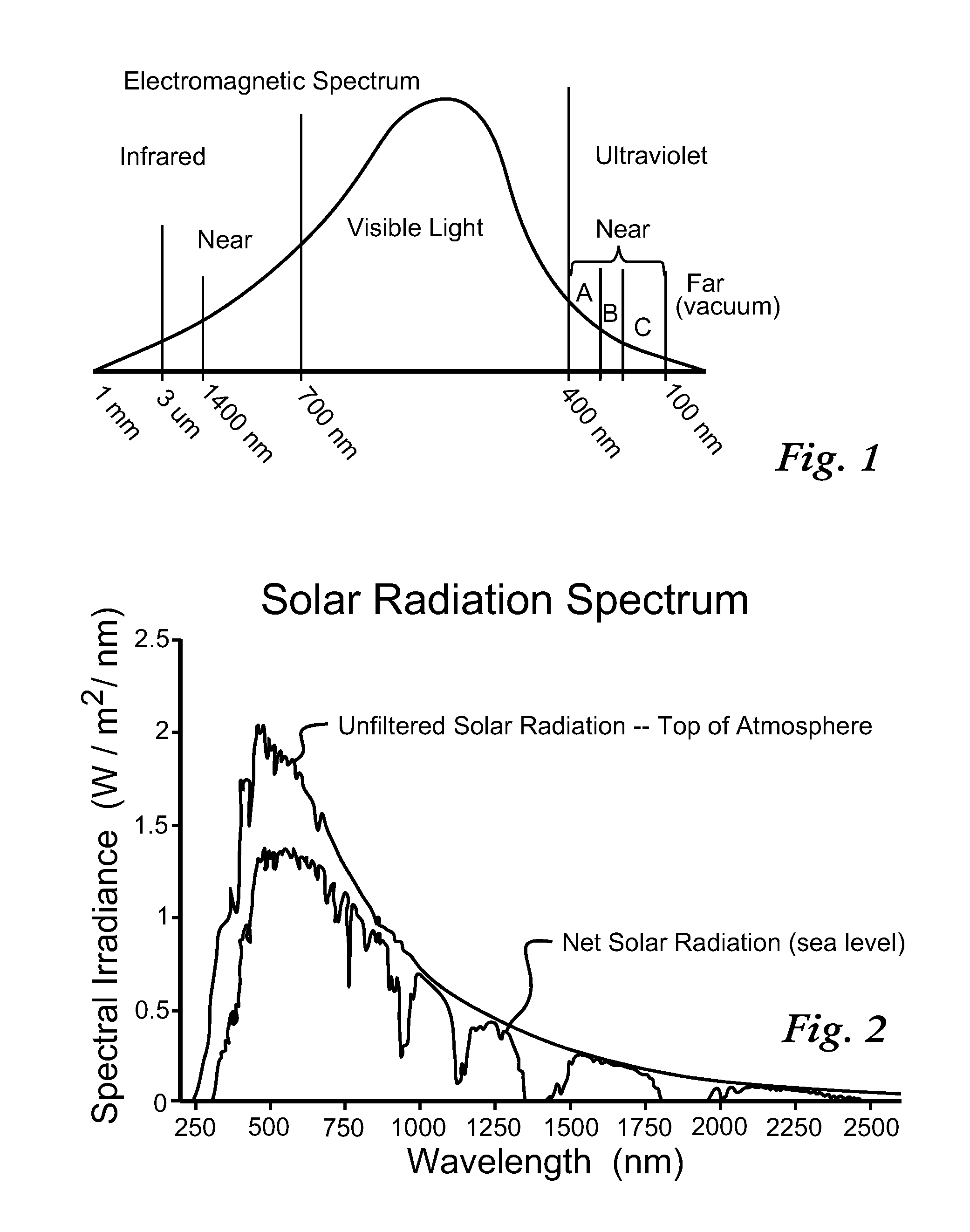Reducing the use of pesticides for weed and plant control has become an issue of national importance.
Ground water is vitally important and the use of herbicides to prevent weeds from growing in homeowner and commercial lawns adversely impacts the quality of ground water.
Most herbicides are persistent, soluble in water, and
ingestion at high
toxicity levels can be carcinogenic, affecting the human
nervous system and causing endocrine disruption.
For example,
atrazine is a toxic, white, crystalline
solid organic compound widely used as an herbicide for control of broadleaf and grassy weeds, and has been detected in concentrations problematic for human and
animal health.
Mechanical and thermal phenomena marshaled against undesirable plants by prior art devices, methods and teachings are not effective overall, and this is due in large part to the natural robustness of plants, due to their
physiology and responses to natural trauma.
Evaluation of effective methods for plant control using largely non-invasive phenomena is a difficult subject area to evaluate for general effectiveness because of many and varied biologic and environmental factors, including
plant species, condition, type, environmental history, solar
insolation, weather, and varied actions of insects, animals and microbiotica.
Fungi, too, can be involved, and their actions, when turned from symbiotic to antagonistic, can be lethal for a plant.
Interactions of a plant with
electromagnetic radiation have been explored, but easy, safe, clean and efficient eradication meeting certain requirements has been heretofore elusive.
In the prior art, basic thermal and mechanical techniques to eliminate nuisance
vegetation are not sufficiently effective for use a commercially viable eradication program or
system.
For long term
exposure of weeks' duration, too much UV-B light can be toxic to some plants.
However, any resulting
lethality is not suited for meeting the purposes served by the instant invention, as discussed below.
Application of thermal contactors or applicators have not met with success.
The heat thus delivered is ineffective or can be beneficial or stimulative, with any
resultant subsequent repair to a root often making the root more robust to future thermal trauma.
Whether or not those same plants grew back, however, is often left unstated in prior art disclosures.
It is not sufficient merely to damage certain components of a plant, such as above-surface foliage.
While visible above-ground damage may be desirable for an operator of a eradication
machine, actual lethality can be short of expectations and short of what is required for a successful eradication
system.
This and other prior art methods which burn or heat plant parts usually fail, because plants have evolved to tolerate—and sometimes be stimulated by, forest fires and
lightning strikes.
Similarly, when
propane and heated ceramics burn off foliage, root structure remains among plants, and many plants regrow.
Many weeds such as crabgrass are fairly transparent to UV-C and the lethality of UV-B for short term applications of low energy is small
in degree and not sufficient for a commercially successfully eradication method.
First, it should be noted that with the various protection mechanisms that plants employ, added amounts of UV
radiation are quite often ineffective, either wholly or in practice, for a suitable process.
However, the root structure remains, and the plant usually is able to adapt as after a forest fire, which inflicts similar damage.
Evaluating the effect of
artificial illumination on nuisance plants can be complex, with competing and conflicting effects and factors.
Prior art techniques have not been successful, overall.
[6] Lamp and
system complexity, cost, the need for controls, ballasts, and safety guards
[7] Operator and bystander safety, specifically often the UV
exposure danger.
This is a significant
disadvantage for prior art methods such as that disclosed in U.S. Pat. No. 5,929,455 to Jensen, which discloses an eradication method using
high energy radiation, high in UV-B and especially UV-C radiation, which is dangerous and mutating.
[8] Ignition
hazard and lamp unit operating temperatures
While some effectiveness has been found using prior art methods, it has only been effective for very large and dangerous radiative transfers.
The reason why these dangerous and very
high energy transfers have been used is because prior art low energy methods have not worked.
The method described by Kaj Jensen in U.S. Pat. No. 5,929,455 uses an extremely
high energy, dangerous process, specifically using UV-B and UV-C which have very high and special, qualitatively different, lethality.
Such emissions, including similar emissions lines from other selected arc
discharge lamps are very dangerous, expensive and require extensive controls and safeguards.
These rays cause very severe flash burns and they were well known to have killed
plant life.
The first flash or
discharge is especially rich in
ultraviolet radiation, which is very biologically destructive.
From the standpoint of acceptable lethality for a success eradication process, all low energy previous prior art techniques have fallen short and have not been acceptably effective.
Generally, the delivery of trauma which resembles natural trauma (e.g., severing, pulling, application of heat etc.) is not effective as bona fide reliable eradication methods, because the plants so treated tend to heal and regenerate, probably as a result of centuries of evolution.
The delivery of illumination trauma in the low energy regime as attempted in the prior art is similarly not effective.
 Login to View More
Login to View More  Login to View More
Login to View More 


